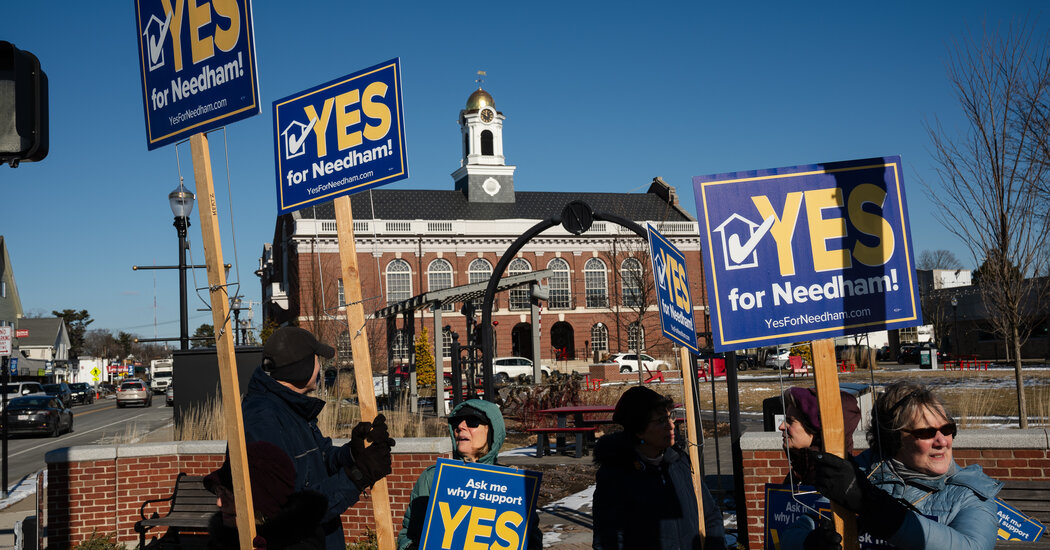Working at a cafe in Winthrop, Mass., for the last seven years, Valdineia Santos fell in love with the seaside suburb of 20,000 people, just north of Boston.
But the two-bedroom apartments she found there rented for about $3,000 per month, considerably more than she could afford. So Ms. Santos and her young daughter stayed put in Malden, a city about a half-hour’s drive inland.
“Maybe someday,” she said, winding down her shift at the cafe recently.
A four-year-old state law meant to increase the supply of apartments in dozens of towns around Boston — ideally putting downward pressure on rents — was passed to help people like Ms. Santos. But the law has had a rough road, with a number of towns arguing that the state cannot force them to allow more multifamily housing.
“It’s taking away the rights of citizens, and transferring those rights away from the people who know the town best,” said Diana Viens, a Winthrop resident who has led a movement there to defy the law. “Has the governor ever set foot here? Has she looked at our plan for our downtown?”
More than 120 complied, opening the door to new multifamily developments. But roughly 30 cities and towns pushed back, hard. Some, like Winthrop, sued the state, arguing that their community should be exempt. Others, such as Needham, west of Boston, held townwide votes, with residents rejecting zoning revisions that they said would change their communities’ character for the worse.
The state has shown no sign of backing down. Andrea Campbell, the attorney general, sued the town of Milton last year after it failed to meet an initial deadline for compliance. Last month, in a critical win for the state, the Massachusetts Supreme Judicial Court ruled that the law was constitutional, and that Ms. Campbell can sue towns to enforce it. Most of the resistant towns signaled last week that they would now comply, submitting preliminary plans to the state.
Because the court also found that the state did not properly seek public input when it created the guidelines in the law, and ruled that it must start the process over, those towns now have until July to complete plans for rezoning.
The conflict echoes others playing out around the country, as elected leaders struggling to address a crippling housing shortage increasingly target restrictive suburban zoning that has blocked new multifamily buildings for generations.
“There’s been a growing realization, the last few years, that restrictive zoning is a real barrier to housing affordability,” said Ben Metcalf, director of the Terner Center for Housing Innovation at the University of California, Berkeley. “Red states and blue states are cohering around this idea.”
In Massachusetts and elsewhere, conversations about zoning cannot be detached from the fact that historically, some saw rules against apartment buildings as a way to keep their towns affluent, and mostly white. That history has heightened tensions around the law, officially known as the MBTA Communities Act, with some proponents calling out what they say is “coded” racist language from opponents.
The opponents say their goal is to preserve local control.
Jeff Turco, a Democratic state representative whose district includes Winthrop, said he worried that his own six children will not be able to afford housing where they grew up. But he said the law takes a “heavy-handed, punitive approach,” by threatening towns that do not comply with the loss of state funding, including for climate change mitigation.
“You can offer incentives to encourage towns to build housing,” he said, “without threatening their existence because they don’t want change.”
Proponents say that incentives are not enough, given how long suburban zoning has kept barriers in place.
“This law opened the wound, called towns to task and said, ‘You can’t do this anymore,’” said Judi Barrett, a housing consultant south of Boston who supports the law.
Restrictive suburban zoning has also hurt the state’s economy, she said. Massachusetts has lost population in recent years, while housing prices continue to spike; the median price for a single-family home in the state topped $650,000 last year.
Yet even some residents likely to benefit from the law say they see potential downsides. Ms. Santos, the cafe worker who dreams of moving to Winthrop, was not familiar with the details of the law or the efforts to fend it off. But she said she fully understood why some residents might be uneasy about it.
“I like the town the way it is right now,” Ms. Santos said. “It’s small and calm, and you know the people. I don’t want it to become more crowded and chaotic.”
Compared with some other towns that have ample land to build on, Winthrop faces complex challenges. With about 19,000 people occupying 1.5 square miles, it has much greater population density and heavier infrastructure burdens than other places, Ms. Viens said. The city hosts the only land access to the state’s largest wastewater treatment plant, as well as part of Logan Airport, on a peninsula with few routes in and out.
“Winthrop was completely built out 20 years ago,” she said. “We can’t afford more density, more congestion. It would create massive risk. It would bankrupt us.”
The law has also been criticized for not going far enough. It does not require developers to set aside units for people with lower incomes, for example, and it allows towns to dodge new development by rezoning areas that are already built out, as some have done.
Still, some housing experts say, new market-rate housing creates vacancies elsewhere. Kevin Connor, a spokesman for the state’s executive office of housing, said the law is just one component of a multipronged effort to ease the crisis, an effort that includes $5 billion in funding to add new housing across income levels.
In some towns, including Needham, opponents of rezoning have focused on keeping changes modest. Needham voters last month rejected a plan that exceeded state requirements, after opponents promoted an alternate version that would allow fewer units.
In Marblehead, a coastal town of about 20,000, where the population is 95 percent white and the median home sales price topped $1 million last year, voters rejected a rezoning plan last spring.
Proponents of the plan say they will try to change voters’ minds by making the case that rezoning will help young adults who grew up there to stay and raise their own children. The plan is set for another vote at Marblehead’s next town meeting, in May.
The age of the average Marblehead resident has climbed to 50 since 1970, according to the census, while the number of children has steeply declined — evidence, proponents say, that young families have been priced out.
“There’s a childhood available here that has been lost to most of the world,” said Peirce Law, a rezoning proponent who grew up there, and recalled riding bikes downtown and swimming off a town dock in the scenic harbor. “I know so many people who would like to buy a house here, so their future children could have that experience.”





